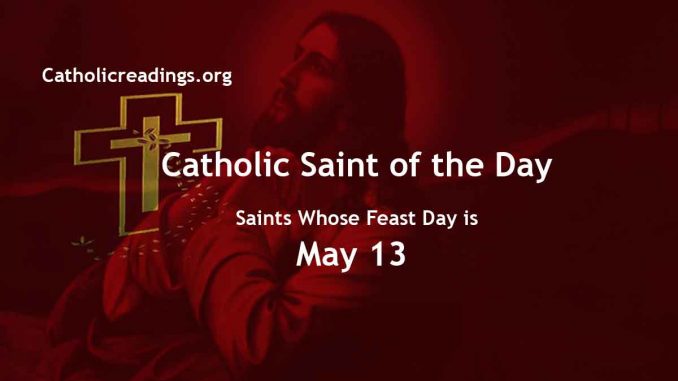This is the Saint of the Day list of Saints and Blesseds whose feast day is May 13 2025.
Blessed Gemma of Goriano
Saint Servatius of Tongeren
Saint Rolende of Gerpinnes
Saint André-Hubert Fournet
Saint Julian of Norwich
Blessed Gerard of Villamagna
Saint Euthymius the Illuminator
Saint Glyceria of Trajanopolis
Blessed Magdalen Albrizzi
Saint Argentea of Cordoba
Saint Merewenna
Dedication of Saint Mary of the Martyrs
The Dedication of Saint Mary of the Martyrs commemorates the dedication of the church of Saint Mary of the Martyrs which was previously a temple of all the pagan Roman gods called the Pantheon, in Rome, Italy by Pope Boniface IV in the year 609.
Saint Agnes of Poitiers
Saint Agnes of Poitiers was believed to have lived as a nun and was an Abbess of the Holy Cross Convent, which was a house of 200 sisters situated in Poitiers, France.
She was assigned there by Saint Radegund and she introduced a rule given to her by Saint Caesarus of Arles. She was a friend of the poet Saint Venantius Fortunatus.
She died in the year 588 AD due to natural causes.
Saint Natalis of Milan
Saint Natalis of Milan was said to have lived as a Bishop of Milan, Italy in the year 740 AD. He was overseer during the difficult period when the Arian Lombards were converting to orthodox Christianity.
He is represented as a bishop near a child that holds a book.
He passed away in the year 751 AD due to natural causes.
Saint Vulfura of Cordoba
Saint Vulfura of Cordoba was born in Gaul, modern France. It was said that he had a dream in which he was told that in Cordoba, Spain, he would meet a young woman with whom he would be persecuted with for his faith and it came to pass after he was imprisoned with and executed with Saint Argentea hence died as a martyr.
He died in the year 973 AD.
Saint Abban the Hermit
Saint Abban the Hermit, also known as Abben or Ewan was born in Ireland in the 4th century. He lived as a hermit at Abingdon formerly known as Abbendun, Berkshire, England.
He was a noted evangelizer and he brought about the founding of a monastery in Berkshire.
He may be the earliest Irish saint and is said to have died in the year 520 AD due to natural causes.
Saint Anno of Verona
Saint Anno of Verona, also known as, Annon of Verona or Hanno of Verona was born in Verona, Italy and lived as a Bishop of Verona, Italy. He is associated with the translation of the relics of both Saint Firmus and Saint Rusticus.
He died in the year 780 AD due to natural causes
Saint Lucius of Constantinople
Saint Lucius of Constantinople was said to have lived as a priest. He was martyred after being imprisoned and tortured at Amphipolis and then Constantinople during the persecutions of Diocletian and Laudicius.
He died in Constantinople.
Saint Mael
Saint Mael, also known as, Mahel or Mel, was born in Brittany, France. He travelled with Saint Cadfan to Wales in the 6th century and was known to have spent the rest of his life as a hermit on the isle of Bardsey. He was acknowledged for his holiness and wisdom.
Saint Valerian of Auxerre
Saint Valerian of Auxerre was remembered to have been the third bishop of Auxerre, France and was known to have fought and opposed Arianism.
He died in the late 4th century.
Saint Mucius
Saint Mucius was born in Byzantium and was said to have lived his life as a priest. He died as a martyr during the persecutions of Diocletian for overturning a pagan altar in the year 304 AD.
Saint Onesimus of Soissons
Saint Onesimus of Soissons was known to have been the fifth bishop of Soissons, France. He died in the year 361 AD.
Martyrs of Alexandria
The Martyrs of Alexandria were said to have been a group of Catholic Christians martyred in the church of Theonas, Alexandria, Egypt by order of the Arian Emperor Valens in the year 372 AD in Alexandria, Egypt.
Other Saint of the Day for May 13 2025
- Our Lady of the Most Blessed Sacrament
- Tighernach of Boirche

Related Links
Powered By SEO Experts
Follow @ReadingCatholic
